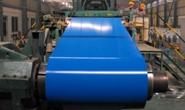Market Data

March 28, 2014
Steel Buyers Basics: High-End and Custom Pre-Painted Steel
Written by Mario Briccetti
The best pre-painted steel coating system (for color retention) is made of Polyvinyl Difluoride (PVDF) and is sold under the trade names of Kynar 500 and Hylar 5000 (people typically call this paint Kynar). A buyer should know that this type of paint system comes with several high-end options that I am going to touch on in this article.
The standard type of PVDF pre-paint steel coating has a total top layer of thickness of approximately 1 mil thick (a mil is 1/1000 of an inch). 75% of this layer is the finish coat and 25% of the layer is the bottom primer. PVDF comes in a wide variety of colors ranging from whites to bright reds to metallic that change color based on the angle you look at them. Typically, whites are less expensive than darker colors, bright colors even more expensive and metallic colors the most expensive.
In some cases customers will specify variations on these PVDF paint systems. Those variations are of three types — the primer thickness is increased, an additional protective clear topcoat is applied and both sides of the steel are painted in the finish coat.
The purpose of increasing the primer depth is to provide extra corrosion protection for the underlying steel. Even though paint is plastic, it is not imperious to water penetration. By increasing the primer depth the paint and steel becomes more resistant to water and corrosive atmospheres. The clear coat on top option provides extra protection against sunlight to prevent fading and chalking and also provides a protection to the gloss level of the paint. Putting the top finish coat (and this could be two different colors) on both sides allows panel to be used where both sides are visible.
Buyers should realize that since these types of hi-end PVDF coatings are special, very expensive and they are almost always quoted on a custom basis. Further, that the paint for some hi-end coatings formulated differently from the typical PVDF paint and can only be used for these special orders. Finally, even if the color is the same, a coil with an added clear topcoat will have a different visual appearance than a coil without the top coating.
In addition, most of these special PVDF coatings require multiple passes thought the paint line, creating double and even triple the amount of additional scrap. Further, that paint lines have minimum amounts of steel that must be painted at a time and finally, paint lines (especially large high-speed lines) cannot control the exact amount of steel they paint in one pass. This uncertainty increases with each extra pass though their paint line.
For buyers quoting these high-end pre-paint systems should include in the quoted price the following factors:
1. All the steel painted with custom paint has to be used on the particular job needing this special paint; any extra painted steel might have to be sold as scrap or secondary.
2. If you are toll-processing plan for and incorporate into the price the extra scrap generated by the paint line.
3. For small jobs, make sure you understand the minimum amount of steel that has to be painted and what all the extras from the paint line are for small jobs. Paint lines can vary widely in their minimum levels.
4. Make sure the paint line is committed to painting at the least the minimum amount of steel you need and that you set a limit on the amount of additional painted steel that the paint line can produce.
Buyers can negotiate items 2, 3 and 4 with the paint line and should make every effort to minimize excess painted material and minimize additional costs for small jobs. Further buyers should inform their salespeople of these costs so they can be properly applied to specific jobs. These extra costs can be a very high percentage of the full price of the special painted steel and may make the difference between being competitive in the market or not.
Finally if a buyer often has special paint jobs to quote, he should work out with the paint line a chart of extras for various options both to save time when quoting and so that prices can be negotiated without the pressure of a quote deadline.
This article was written by Mario Briccetti, CEO of Briccetti and Associates. Mario can be reached at mario@mbriccetti.com






